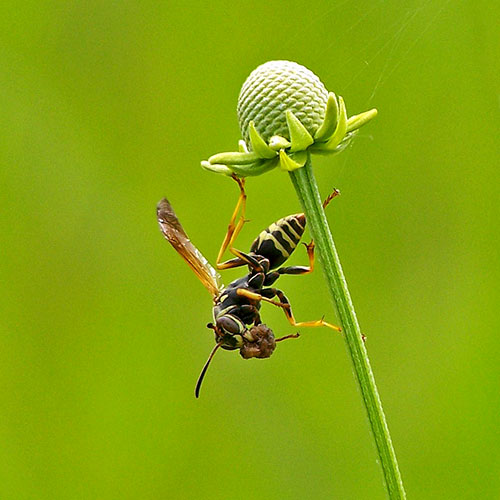Howdy, BugFans,
Most of our bees and wasps live solitary lives, and when the time comes to lay eggs, they build a variety of types of nursery chambers, provision them with food for their potential young ‘en (the BugLady labored mightily and unhappily through discussions of “actual” and “potential” in her required philosophy courses) and leave. Some solitary wasps have earned the name “mud dauber” because of their chosen building material. This small, black mud dauber, also called the Jug Builder, throws a pot the shape of a small (about ½ inch) jug. It is unusual that her bit of adobe was fastened to a Queen Anne’s Lace flower; she more commonly builds several jugs in a row on a small branch, finding and transporting, one by one, small globs of mud.
[metaslider id=7198]
The potter wasp mixes hair into the mud she finds, strengthening it against the rain. Then she hunts, anesthetizing two or three caterpillars and stuffing them into the jug (her own food is nectar from the flowers she visits). When she has provided enough food, she suspends her egg inside and closes the top with a mud plug. She will not start a new pot until the previous one is complete. The egg hatches, and the larva dines. It spends its larval and pupal stages inside the jug (constructing a pupal case would be superfluous); the adult wasp will chew its way through a wall when it emerges within the jug.
As the BugLady and her camera approached the solitary wasp that is holding a caterpillar in her mandibles, she saw a spider drop from the flower bud above the wasp. Apparently, the spider had attempted to collect the wasp (you can just see the web going northeast from the flower). The BugLady apologizes for interrupting.
[metaslider id=7202]
The BugLady had a chance to photograph a different wasp-spider drama. As the BugLady interprets it (albeit a bit fuzzily—the arthropods were vibrating and the BugLady isn’t too steady herself, anymore), the wasp had captured a spider and was flying it to a prepared mud chamber when she ran into the web of another spider and got stuck. The larger of the two resident spiders (presumably the female; that’s probably Dad in the background, and an egg case) eventually subdued and started wrapping, for a future meal, both wasp #1 and her catch, which she did not release even when the going got tough. The Arthropod world is pretty much without sentiment.
When the BugLady was researching the mud chambers of the potter wasp, she found good information in the venerable Handbook of Nature Study by Anna Botsford Comstock. Written at a time when Nature Study was an integral part of the curriculum for all ages, Mrs. Comstock’s book has great information and teaching questions on animals, minerals and vegetables for NatureFans of all ages.
The BugLady
